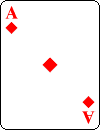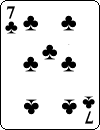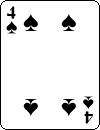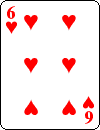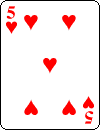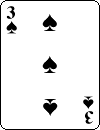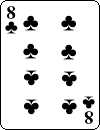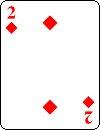- About MAA
- Membership
- MAA Publications
- Periodicals
- Blogs
- MAA Book Series
- MAA Press (an imprint of the AMS)
- MAA Notes
- MAA Reviews
- Mathematical Communication
- Information for Libraries
- Author Resources
- Advertise with MAA
- Meetings
- Competitions
- Programs
- Communities
- MAA Sections
- SIGMAA
- MAA Connect
- Students
- MAA Awards
- Awards Booklets
- Writing Awards
- Teaching Awards
- Service Awards
- Research Awards
- Lecture Awards
- Putnam Competition Individual and Team Winners
- D. E. Shaw Group AMC 8 Awards & Certificates
- Maryam Mirzakhani AMC 10 A Awards & Certificates
- Two Sigma AMC 10 B Awards & Certificates
- Jane Street AMC 12 A Awards & Certificates
- Akamai AMC 12 B Awards & Certificates
- High School Teachers
- News
You are here
Sum-Rich Circulants
June 2008
Summing beads on various types of numerical bracelets has been a recurring theme here over the past year or so. Generally, the summed beads have been adjacent and the totals arrived at more or less predictable, leading to "sum-poor" magic tricks, e.g., see any of the April, August, or October 2007 Card Colms. By contrast, in February 2008, sum-rich effects were introduced, without any adjacency restriction. This time we investigate a similar situation, but only for sums of adjacent beads. Thanks to Neil Calkin for hinting that this eventuality was worth considering in a magic context.
The numbers/beads 1 to 8 inclusive can be arranged in 7!/2 = 2520 ways in a (reversible and spinnable) circle/bracelet. We focus on the g4g8 bracelet determined by the permutation
which can be visualized with cards as follows:
|
|||||||||||||||||||||||||||||||||||||||||||||||||||||||||||||||||||||||||||||||||||||||||||||||||||||||||||
This array first saw the light of day at the g4g8 conference in Atlanta in March 2008. Counting out 1, 2, ..., 8, reveals a "suitable" geometric pattern; classic cycling CHaSeD order is used.
You way wish to disguise the fact that you know anything about the cards in the bracelet, by starting with these cards in order on the top of a deck, and maintaining them there throughout some fair-seeming shuffling, before dealing them in a (face-down) circle.
In any case, have three adjacent cards peeked at by different spectators, while you turn away, and their values summed. Explain that Jokers are worth 0, Jacks 11, and so on; it adds to the illusion that any cards could be involved. Either ask outright what the total is, or find out surreptitiously, e.g., perhaps by shuffling a second prearranged deck as suggested in February 2008.
From knowledge of the sum, you can deduce the identity of the three original cards, assuming that you have memorized the card suits in advance. The reason is that this bracelet is sum-rich for triples: the eight possible sums of three adjacent card values are distinct. In fact, we get the numbers:
15, 17, 10, 12, 14, 16, 11, 13.
Here we list the triple sums in the order in which they show up, as we go around the bracelet, based on the central element of each sum, so that 15 = 2 + 8 + 5 is listed first, followed by 17 = 8 + 5 + 4, etc. Notice that these sums are the eight consecutive numbers 10, 11, 12, ..., 17 in a special order.
It would be nice to have an easy way to determine which three numbers sum to a given total. Look at what happens when 8 is subtracted from each possible sum; we obtain these numbers:
The order in which these occur can be deduced from the phrase:
Hence, if the triple sum is 14, first subtract 8 to get 6, then easily determine that this corresponds to the fifth position in the original bracelet. As long as you remember the suits as well as the values, you know that 7♣ and its neighbours A♣ and 6♥ were the chosen cards, which you can now identify to wild applause.
It all boils down to remembering [8 5 4 1 7 6 3 2], which is easy. The g4g8 bracelet first displayed above can be viewed as a capital omega (Ω), which brings to mind the word "alphabetical." Eight, Five, Four, One, Seven, Six, Three, Two are indeed in that order—it's as easy as A, B, C!
Disdain Tin Calculator
A well-known principle in which a fixed outcome can be guaranteed (and hence predicted, seemingly defying the odds) is the book force: if we can be sure of getting the number 15, say, as the outcome of an apparently random process, then the beginning word on page 15 of a particular book can be predicted (or "mind read"). Here's a twist on that concept which effectively reverses the flow of logic.
Have three cards selected as above, and their values summed. Hand a copy of Martin Gardner's classic Mathematics, Magic and Mystery (Dover, 1956) to an audience member. Pull out a calculator and say, "Many mathemagicians would resort to calculations at this point to figure out what the chosen cards were, instead all I ask for is a verbal cue." Set the calculator aside with obvious disdain, and enquire what the beginning word (ignoring chapter titles and page headers) is on the page corresponding to the sum found. As the second row in the table below reveals, the answer allows you to deduce the unknown sum, and hence, as before, the identities of the cards.
| Sum/Page | 15 | 17 | 10 | 12 | 14 | 16 | 11 | 13 |
| Page begins | Courtright | Behind | The | Diamonds | turning | Method | zero | After |
| Page ends | case | In | considered | concerned | in | before | of | pairs |
Actually, you don't really need to know the beginning word in question: have the audience member concentrate on it and just tell you how many letters it contains. Then pretend to do a little mind-reading. If the answer is anything other than six, you are home and dry. If the answer is six, say "I see a 'd', is the last letter a 'd'?" You can do something similar for the 'e'. Then continue, "I see an 'h', is the third letter a 'h'?" The answer is all you need to know to complete the mind-reading and identify the three cards.
You could, instead, ask for the ending word on the page; those possibilities are given in the final row of the table. You can ask if the first letter is upper or lower case to get around the one potential ambiguity.
Tactic Ordinal Sundial
As well as being sum-rich, the g4g8 bracelet determined by the permutation [8 5 4 1 7 6 3 2] is also product-rich.
For triple adjacent products we can use the same book page/word ideas we did earlier, based on the following table.
| Product/Page | 80 | 160 | 20 | 28 | 42 | 126 | 36 | 48 |
| Page begins | Another | Magician | Although | three | Almost | - | to | position |
| Page ends | are | diffi-cult | the | order | pro-vides | - | bottom | monthly |
The triple products are listed in the order in which they show up, going around the bracelet, starting with 80 = 2 x 8 x 5, 160 = 8 x 5 x 4, etc. As before, we list the beginning and ending words on each page; the two hyphenated words in the final row begin on the bottom of the appropriate page but continue onto the next one.
The "-" entries reflect the fact that page 126 has no text, it's just a figure. This can be played up in performance, you can say, "There are no words on the page you turned to, other than the chapter header? That makes it really tough for me. I may just have to read your mind." It's a good idea to familiarize yourself with all of the pages which can arise so as to be able to deal with any queries that come up.
The g4g8 bracelet is also product-rich for adjacent pairs, yielding the products:
40 20 4 7 42 18 6 16
and for four adjacent beads, yielding the products:
160 140 168 126 252 288 240 320
Hence, it's also product-rich for any number (say five) adjacent beads. Of course, larger products will require a larger book to work with!
Note that the triple sums and triple products considered and the words at the beginning or end of each corresponding page are disjoint too, which allows for a fun variation as follows. Have three adjacent cards selected and say, "I'd like you to add or multiply—I don't care which—the values you got, and turn to that page of this book. What is the first word of text there?" You can name all three cards provided that you have memorized the tables involved.
Crucial Addition Slant
The permutation [8 5 4 1 7 6 3 2] which generates the g4g8 bracelet is far from being the only ordering which yields distinct triple sums. E.g., straight numerical order 1, 2, 3, ..., 8, yields these totals:
11 6 9 12 15 18 21 16
Some permutations, e.g., [8 2 3 5 1 6 7 4], yield distinct double sums (but not distinct triple sums), and hence can be used to identify two cards based on the sum of their values. Since 5 + 4 = 6 + 3, our favoured [8 5 4 1 7 6 3 2] does not yield distinct double sums.
There are also numerous permutations, such as [2 3 5 7 8 4 6 1], that yield distinct quadruple sums as well as distinct triple sums. For such permutations, the sums of four adjacent card values could be asked (or fished) for, and all four cards successfully named. Again, our favoured [8 5 4 1 7 6 3 2] fails on this count.
Note: those of an octal bent may wish to work with the equally alphabetic [5 4 1 7 6 3 2 0] instead, making modifications as required.
Cards Laid Until Action
If we snip off the first bead (8) of the g4g8 bracelet and leave it open (unlooped, e.g., a row of cards), we obtain one to seven in alphabetical order:
[ 5 4 1 7 6 3 2 ]
This can be checked to be sum- and product-rich for adjacent triples. Even shorter bracelets are also easily explored.
The open bracelet
[ 8 5 4 9 1 7 6 3 2 ]
(one to nine in alphabetical order, with the ends not joined) is sum-rich for four adjacent beads, yielding the sums:
26 19 21 23 17 18
If we alphabetize all ten digits—in a row of cards a Joker can be used in place of the zero—we obtain the open bracelet:
[ 8 5 4 9 1 7 6 3 2 0 ]
which is also sum-rich for four adjacent beads, yielding the sums:
26 19 21 23 17 18 11
Here is a mnemonic that may help out with the last two cases: given the total, subtract 10 and see which word length the answer corresponds to in the phrase:
(I) remember nothing calculational effectively eliciting disqualification
—said backwards! It's a bit of a mouthful, but the pay-off is the ability to name four adjacent cards from a "random row" knowing only the total value.
Curiously, the modified open bracelet [0 8 5 4 9 1 7 6 3 2] has adjacent sums of five beads alternating 26 and 27, i.e., is sum-poor, which is more or less where we came in.
(On an unrelated note, Martin Gardner points out that the number 8549176320 has another curious property: divide it by 5... once then twice. Notice anything?)
Colm Mulcahy (colm@spelman.edu) completed his PhD at Cornell in 1985, under Alex F.T.W. Rosenberg. He has been in the department of mathematics at Spelman College since 1988, and writing Card Colms—the only MAA columns to actively encourage lying on a regular basis—bi-monthly since October 2004. For more on mathematical card tricks, including a guide to topics explored in previous Card Colms, see http://www5.spelman.edu/~colm/cards.html.
"Disdain Tin Calculator," "Tactic Ordinal Sundial," "Crucial Addition Slant" and "Cards Laid Until Action" are all anagrams of each other, and of something else interesting.

